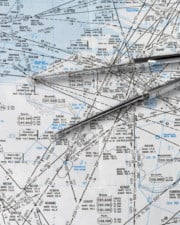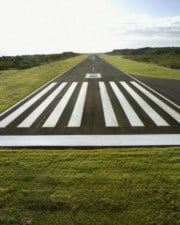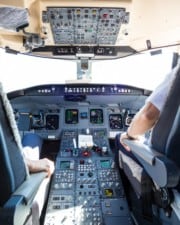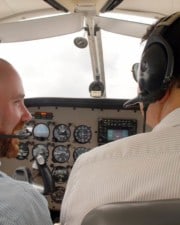Learning basic aerodynamics starts by studying the various forces acting on a plane. The four forces of flight are lift, thrust, drag, and weight. Each one of these items is complicated in its own right. Let’s take it one step further and explain the aerodynamic center and the center of pressure.
Table of Contents
Pilots think of lift as one arrow that points up. But how do you even begin to come up with one arrow that depicts all of the lift forces acting on a plane?
The answer turns out to involve two important terms—the center of pressure and the aerodynamic center. Both terms describe the lift that a wing makes due to changing air pressure around it. The center of pressure is the average of all pressures a wing makes, while the aerodynamic center is a simplified point that’s easy to use in lift computations.
Why are Aerodynamic Center and Center of Pressure Important?
Aerodynamics is a complicated science. To understand it requires knowing quite a bit about physics and fluid dynamics. It might seem counter-intuitive, but most pilots don’t know a lot about aerodynamics as a science.
Think about it—do you think about the friction of your tires and how they will affect turning off of a highway in a car? Of course not–you just know it will work—within limits—and you keep driving safely.
But when you dive into the minutiae of aerodynamics theory, you’ll really begin understanding how an aircraft operates. Of course, doing so requires knowing some basic terminology and how it applies in the real world.
But each one of these is complicated! Especially lift, which is unlike anything you’ve probably studied before. You learn about Bernoulli’s Principle and how the wing makes lift. To visualize it all, we use vectors—arrows that depict the sums of all forces on a plane.
What is Meant by Center of Pressure?
A wing generates lift because the velocity of the air traveling over its surface is not consistent. The air flows faster in some areas and slower in others.
The shape of a wing is carefully crafted to harness this difference in velocities. The shape is called an airfoil, and it makes it so that the air flowing above the wing moves faster than anywhere else.
These speed changes also mean changes in pressure. Bernoulli’s Principle states that a faster-moving fluid exerts less pressure. So the faster-moving air above the wing creates less pressure than anywhere else around the wing.

But that’s a simplistic picture of what’s actually happening. Aircraft designers and engineers study the pressure differences all around the airfoil very carefully to optimize the effect.
What results is a carefully drawn map that shows how much pressure every zone of the airfoil is experiencing. But that’s not very helpful, because it’s too much information. All they really need to know is where all of those pressures average.
And that’s exactly how they calculate the center of pressure. This is the average of all the different pressures on the wing. Since it’s an average, it is affected by all of its components. It’s constantly moving around and changing as the environment around the wing changes.
Center of pressure is not an aeronautical term. It actually comes from the science of fluid dynamics. It’s used to describe the forces acting on everything from the keels on sailboats to the pressures on a rocket ship or missile.
So changes in aircraft speed or angle of attack will have big repercussions for exactly where and how big the center of pressure is.
What is the Aerodynamic Center?
Figuring out the center of pressure for every region of flight is still pretty complicated. It’s an essential part of how the wing works and figuring out exactly which angles of attack will work best. But it’s hardly the sort of thing that most pilots think about while flying through the clouds.
The aerodynamic center is often used to keep things simpler when discussing all of the different things going on with an aircraft in flight.
While it is a generalization, it has been found that on the airfoils of most airplanes, the aerodynamic center is about one-quarter of the way from the front of the wing to the back.
The number isn’t consistent between different types of aircraft, however. For example, supersonic aircraft will have their aerodynamic centers about halfway back on the chord line.
Both theoretically and through experimentation, it has been proven that the aerodynamic center remains consistent for any angle of attack.
What changes, of course, is the amount of force acting on the wing. Specifically, a twisting turn or torque moment is experienced and changes with the various angles of attack. If the wing were not attached to a controlled aircraft, then it would spin out of control.
Relationship Between Aerodynamic Center and Center of Pressure
Both of these forces sound similar, but they are used very differently. Of course, as with any very technical subject, some people use the term interchangeably, which adds to the confusion.
And while these two numbers are very similar, one often changes (Center of Pressure) while the other remains in a constant position on the wing (Aerodynamic Center). As such, the aerodynamic center is the most often used of the two when doing mathematical analysis.
What is the Difference Between Center of Pressure and Center of Gravity?
Going back to those four basic forces of flight—lift, weight, thrust, and drag—the center of pressure involves lift while the center of gravity involves weight.
Both of these terms are averages. They are ways for us to easily visualize what is probably too complex for our minds to handle at once. The forces acting up or down on an aircraft come from many different locations. But each can be averaged down to one vector.
A vector is a physical tool used for complex movement and motion calculations. Vectors are easy to understand and an accurate way to predict resultant forces.
When discussing lift, the aerodynamic center is the vector that is usually discussed.
But when talking about gravity and weight, it is the center of gravity (CG). Much like the center of pressure discussed above, the CG is one vector that describes the average of all of the weights loaded in the aircraft.
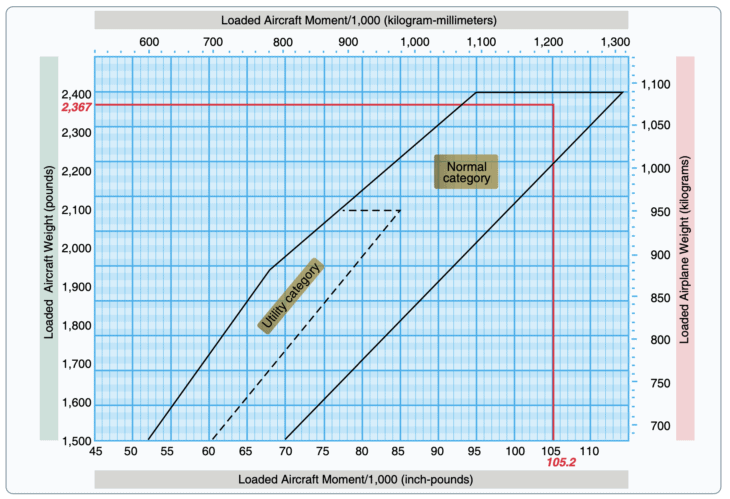
While the center of pressure and aerodynamic centers are essential to making an aircraft fly, most pilots don’t think much about them. The CG, on the other hand, is always on the pilot’s mind. You see, there are very specific limits for where the CG must be located. Improper loading of an aircraft can be deadly.
So, pilots calculate the aircraft’s weight and balance before every flight. Part of this calculation includes finding the exact location of the CG and ensuring that it is within acceptable limits.
You can find more information about lift and the center of gravity in Chapter 5: Aerodynamics of Flight in the FAA’s Pilot’s Handbook of Aeronautical Knowledge.
Related Posts


